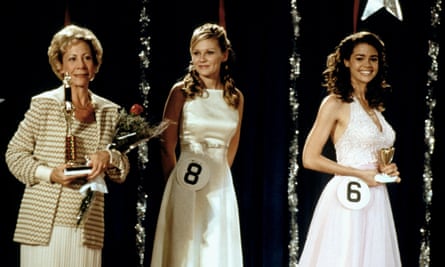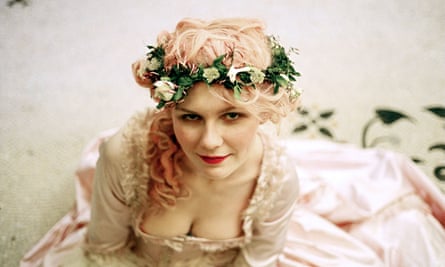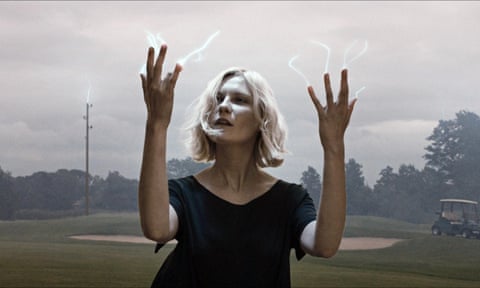20 Hidden Figures (2016)
A rare unsympathetic outing for Kirsten Dunst in this much-loved true-life biographical drama about the African American female mathematicians at Nasa in the 60s, whose work was vital in getting the US into space. Dunst plays the white supervisor, Mrs Mitchell, who is coldly and blandly racist towards the women, and the role plays on her ability to project hostility.
19 Mona Lisa Smile (2003)

There’s something a bit by-the-numbers about this drama starring Julia Roberts as the unconventional art professor at the 50s women’s college who inspires the students. But Dunst has some big scenes as the smugly reactionary married student, Betty, who cannot come to terms with the fact that her marriage has become a sham. It is Betty who tearfully shows her uncaring mother a picture of the Mona Lisa and wonders what pain is concealed by her smile – any woman’s smile.
18 Wimbledon (2004)
This was the Richard-Curtis-style romcom that gave us a boyish Paul Bettany as the stammeringly Grant-esque tennis player who isn’t terribly good at tennis any more, meeting-cute at Wimbledon with the supercool bad girl of American tennis played by Dunst. The romantic spark reignites his tennis skill. Dunst gives it all she’s got but a straight romantic lead doesn’t quite work with her reserved and complicated emotional presence.
17 Get Over It (2001)
The late 90s and early 00s became a new golden age of the Hollywood high school comedy, and Dunst was pretty much the cheerleader in chief. In this rather decent example, Ben Foster plays Berke, a heartbroken guy not getting over a breakup, and Dunst is Kelly, his best friend’s sister – smart, pretty and nicer than the vacuous mean girls. Kelly is in love with Berke, and their relationship blossoms during a school production of A Midsummer Night’s Dream. Kelly (playing Helena) has a great song at the end.

16 The Cat’s Meow (2001)
Peter Bogdanovich revisited the aristocracy of Old Hollywood for this true-crime mystery based on the unsolved Hollywood Babylon case of the man who died mysteriously on William Randolph Hearst’s yacht. Dunst plays Hearst’s legendary protege and lover, Marion Davies. She is no airhead with a sugar-daddy complex, but a complex woman aware of her compromised position (which includes a flirtation with Charlie Chaplin), but able to accept it because of a belief that love will conquer all.
15 Dick (1999)
One of the funniest films about Watergate was this ingenious counterfactual teen spin on the great political conspiracy. Dunst and Michelle Williams play two 15-year-old girls in 70s Washington who live in the Watergate building, and, one night, chance across the notorious burglary. From there, they find themselves in the White House, with Dan Hedaya playing Nixon himself. As ever, ditziness and blondness is weaponised into comedic strength, though it’s Dunst who plays the straighter of the two girls.
14 Little Women (1994)
In the mid-90s, Dunst emerged as a child actor with something mature and complicated about her. Two movies – wholesome and unwholesome – showcased this intriguing new talent. The wholesome one was Gillian Armstrong’s spirited and engaging version of the Louisa May Alcott classic, in which Dunst played the twinkly-eyed younger Amy March, who was one day to grow up and marry Laurie.
13 Crazy/Beautiful (2001)
Dunst gave an underrated and under-appreciated performance in this star crossed lovers drama. She plays Nicole, the daughter of a wealthy US congressman; she falls for Carlos, a smart Latino boy from the wrong side of the tracks. Her dad offers to pay Carlos’s military school fees if he will leave Nicole alone. Dunst brings the maturity of someone 10 or 20 years older to her role.
12 Wag the Dog (1997)

An amusing cameo for Dunst as the utterly confused LA wannabe star Tracy Lime, who is cast by Robert De Niro’s spin doctor in the fake news clip he’s devising as part of his diversionary bogus war. She has to play the fleeing Albanian refugee with a kitten in her arms – only she’s running in front of a greenscreen holding a bag of chips, which will be digitally replaced later, and De Niro tells the wide-eyed Tracy that she mustn’t tell anyone about this. “Is is a guild thing?” she asks. Some Dunst fans feel that her greenscreen acting here is a premonition of her later role playing opposite Spider-Man.
11 The Beguiled (2017)
In her mature years, Dunst is periodically cast in schoolmarmish roles, and here is one with a weird hint of her breakthrough in Little Women. It’s the steamy, saucy American civil war tale from Dunst’s longtime director Sofia Coppola, featuring a wounded union soldier, played by Colin Farrell, who fetches up at a ladies’ seminary in the south whose ladies are all of a-flutter. Dunst plays the assistant to the headmistress (Nicole Kidman) and, like everyone else, she is secretly overexcited at this great big sweaty hunk of man.
10 Drop Dead Gorgeous (1999)

Dunst played the young beauty-queen hopeful in this cult mockumentary about the horrific world of teen pageants, hoping a win will be her ticket out of the boring Minnesota town in which she finds herself. Dunst had to hold her own against some of the most scene-stealing comic turns imaginable: her boozy mom, played by Ellen Barkin, and her mom’s plain-speaking best friend, played by Allison Janney, together with Amy Adams and Brittany Murphy as rivals for the tiara. As so often, Dunst is playing a basically straight role, but doing so with absolute sincerity and class.
9 All Good Things (2010)
Dunst’s capacity for poignancy, pathos and victimhood is explored in this interesting drama based on a true-crime scandal, directed by Andrew Jarecki, who made the documentary Capturing the Friedmans, and went on to made a TV series exploring the real case this was based on. Dunst plays the free-spirited woman who married a wealthy young man (Ryan Gosling), initially a rebel against his rich background, who becomes more and more unpleasant, the more he is sucked back into his father’s dodgy, lucrative affairs. Dunst is very good as suggesting the claustrophobic unhappiness of a shy, romantic person.
8 The Virgin Suicides (1999)
Dunst was the first among equals playing one of the entrancingly mysterious and tragic sisters in 70s Michigan who fascinate the boys next door in this unsettling, emo-ish romance of doom, directed by Sofia Coppola. Dunst plays Lux, the boldest and most free-spirited of the girls, whose mystique has something dark and tragic about it, since her youngest sister attempted to take her own life. Dunst’s precocity and maturity come across in this role with intensity and discreet passion.

7 The Power of the Dog (2021)
Dunst found a return to form in Jane Campion’s award-winning western psychodrama – again, in a movie in which she is in danger of being upstaged by the more showoff performers, she always makes her presence felt. In 1920s Montana, she is the widow with a sensitive teen son (Kodi Smit-McPhee) who, on getting married, finds herself being bullied by psychotically insecure new brother-in-law, played by Benedict Cumberbatch. Again, she brings presence to a role of injured sensitivity and pride.
6 Bring It On (2000)
Here is a cheerleader comedy that spawned a franchise and anticipated the Step Up and Pitch Perfect movies; it clearly emerged from the same era that gave us American Pie and American Beauty – but interestingly alluded to racial difference, which most Hollywood movies of that era (or maybe any era) didn’t. Dunst is Torrance, the pampered-princess chief cheerleader of a team that finds itself facing off with competitors from East Compton in LA, led by Gabrielle Union: plenty of needle but also much mutual respect at the last.
5 Interview With the Vampire (1994)
This was the unwholesome film that made Dunst a star – alongside the wholesome Little Women that same year – playing the infant vampire Claudia. Some Dunst fans believe she has never quite equalled the strange precocity and subversively toxic primness of the role, particularly her great transformation scene with Brad Pitt and Tom Cruise who, as Louis and Lestat, are to be her non-heteronormative vampire family.
4 Spider-Man films (2002-2007)

Dunst was destined to play Mary Jane Watson, the unattainable love interest of Peter Parker and Spider-Man, with Tobey Maguire as Spidey himself. Dunst could play all the attributes: smart, sensitive, a bookish yet attractive person on whom crushes were to be had – with the girl-next-door vibe, but also game for adventure. Dunst is the classic Mary Jane in many ways, though in Spidey’s shadow – and the impression she makes deteriorates as the franchise itself declines. The first movie gave her one of early 21st-century Hollywood’s classic screen kisses, snogging with Spider-Man as he hangs upside down in the rain.
3 Melancholia (2011)
In 2011, Dunst was to join the ranks of those stars (Nicole Kidman, Bryce Dallas Howard, Björk) who agreed to put themselves under the bewildering and even terrifying control of the veteran arthouse provocateur Lars von Trier. Dunst was to have a happier time than many in this film, and her performance won her the best actress award at Cannes. She plays the depressed Justine, whose wedding day is marred by emotional tensions; she descends into depression but then finds herself ecstatically thrilled by the news that a huge blue planet is going to crash into Earth. She wanders outside to bathe naked in the planet’s ethereal blue light. However silly, the film provides an operatically strange role for Dunst, something to get her teeth into.
2 Eternal Sunshine of the Spotless Mind (2004)
Dunst plays Mary Svevo, assistant to Tom Wilkinson’s memory-erasure specialist in this hugely loved movie from screenwriter Charlie Kaufman and director Michel Gondry. The movie is about the memory-tormented lovers Jim Carrey and Kate Winslet, both giving star-quality performances – but it is Dunst’s poor, sad, shy Mary who crucially recites the lines from Pope that give the film its title: “How happy is the blameless virgin’s lot! / the world forgetting, by the world forgot. / Eternal sunshine of the spotless mind! / Each pray’r accepted, and each wish resign’d.” Is she falling in love with her boss? Perhaps. But there is a terrible revelation in store for her.
1 Marie Antoinette (2006)

In Marie Antoinette, director Sofia Coppola gave Dunst her greatest role, the one that allowed Dunst to play on her talent for maturity and precocity, and also a high-status bearing bordering on entitlement. She can play romantic and sexy, but with a sisterly perspective, a way of seeing the reality behind the glamour, demythologising the feminine mystique she is obliged to project. Dunst is an actor who had made a very public progression, from teen roles to mature and melancholy ones. She and Coppola seem to riff on this with the great scene in which Marie Antoinette is taken from her Austrian homeland into a royal tent, and emerges into the Versailles court, where she would be queen – an instant and disorientating growing-up process. She was the very embodiment of doomed youth.
